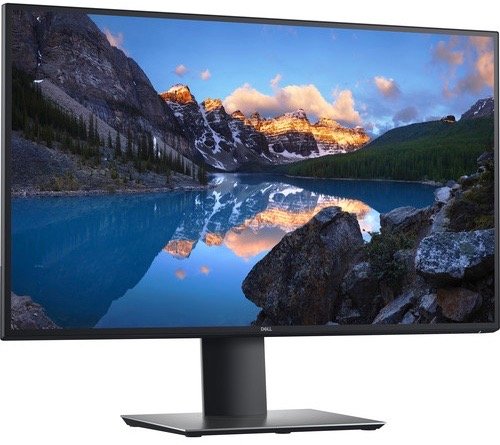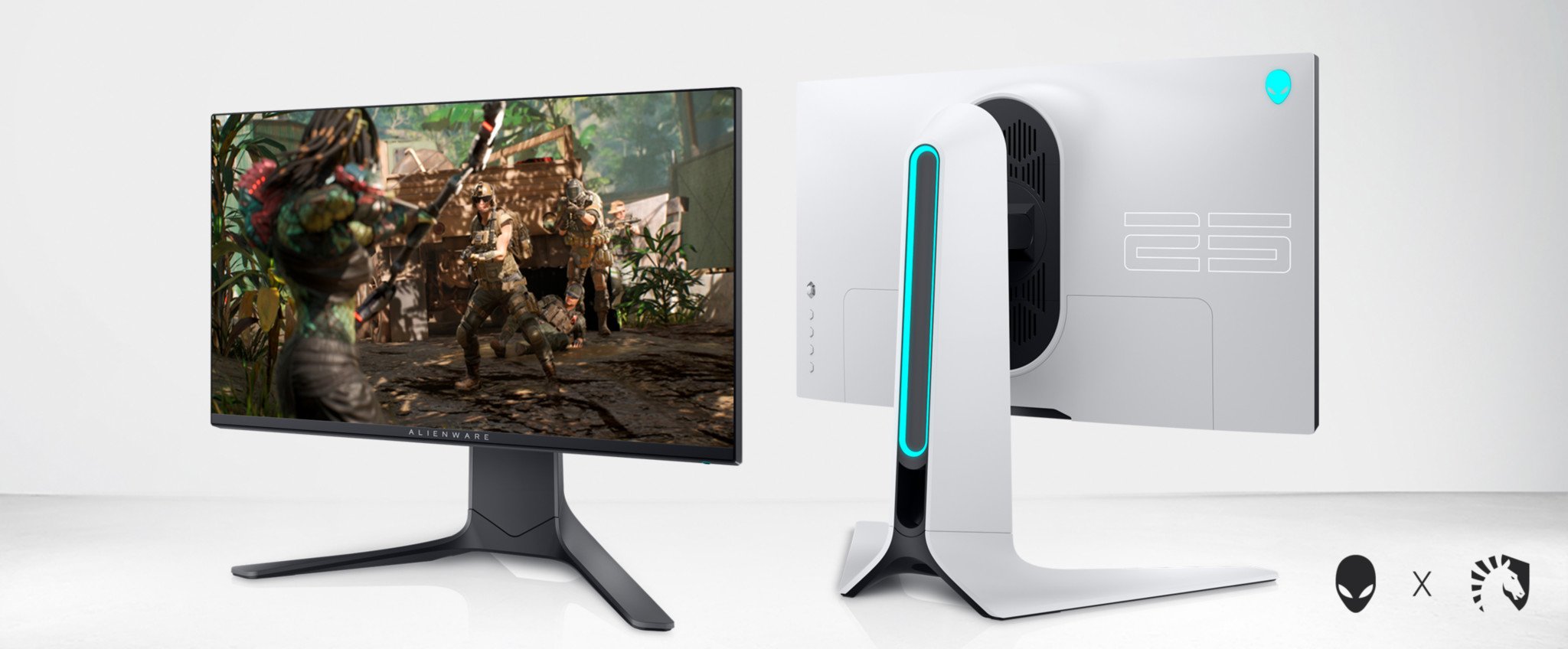Try these Dell monitors for versatile, high-class desktop expansion
To decide which of the best Dell monitors to add to your PC or laptop, we focused our choices on the displays that our readers should reasonably expect to pay for an accessory. Dell technically sells $4000+ "monitors" that are larger than your TV, and beneath those are a variety of giant curved models and other premium devices that only a handful of professionals will need for color accuracy. What truly matters is that Dell sells several reasonably-priced monitors that will appeal to any student, artist, or gamer in need of more desktop space, such as the excellent 27" P2720DC USB-C Monitor.
Best overall: Dell 27" USB-C Monitor (P2720DC)With its QHD resolution, the P2720DC strikes the right balance between gaming-centric or budget 1080p monitors that just don't look amazing and the more expensive 4K monitors that cost as much as a laptop. At 2560x1440 resolution with a high PPI density and 350 nits of brightness, you get a level of aesthetic quality that will fit the vast majority of shoppers' needs without breaking the bank.
The Dell 27-inch Monitor supports the option to create custom desktop personalizations that squeeze as many applications as possible into each window partition. But you can also simply plug in your laptop via USB-C and not bother with any configuration, and leave your laptop charging via the monitor's 65W power supply without needing to rely on your power brick.
The monitor is fairly compact in-depth, so you should have no trouble fitting it on your desk. And it also swivels, pivots, and tilts in various directions for the perfect viewing angle. However, the IPS panel design lets you see the screen clearly even at a 178-degree angle - potentially useful in a workplace setting. It has the same 5ms response time and 60Hz refresh rate as the other non-gaming Dell monitors, which won't win any gaming prizes but is good enough for non-competitive fun.
Pros:- Good price for QHD resolution
- Plug-and-play
- Laptop charges and connects to display via one cord
- Flexible monitor screen movement
- Easy Arrange saved window configurations
- Same gaming, contrast, brightness specs as more expensive models
- Somewhat limited color range
- Only 60Hz
Hits the resolution sweet spot
This 27" USB-C monitor delivers middle-of-the-road specs, high-quality features, and a mid-range price.
Best 1080p monitor: Dell 24" Monitor (P2419H)Monitor shopping for most shoppers is about compromise. Anything past certain spec benchmarks - 1080p resolution, 60Hz refresh rate, a certain level of brightness - is going to cost more than many customers are willing to pay. Because of this, these customers should choose a monitor like the Dell P2419H, which will extend your screen space for a low price even if it doesn't offer flashy improvements like 4K.
Compared to other 1080p monitors, the P2419H stands out thanks to its adjustable stand. You can slightly raise or lower the monitor, tilt the screen upwards, swivel it left or right without moving the base, and even pivot it a full 90 degrees to make it 24 inches tall, should that prove useful for whatever reason. In its normal state, you'll find the narrow bezel along the top and sides, maximizing screen space. It also has several ports, including upstream HDMI, DisplayPort, and USB 3.0 to display content, plus four downstream USB ports to charge your devices.
Otherwise, its specs are fairly standard but have no weak points. We like that it has an IPS panel with ComfortView, which means you get a clear view of the screen at nearly any angle while minimizing blue light and flickering. A 1000:1 contrast ratio with 250 nits is a fairly regular baseline for value monitors that look normal but lack the vibrancy and brightness of a more expensive unit. Finally, its response time varies from 8 to 5ms, which, combined with a 60Hz refresh rate, proves this isn't built for gaming but will work well in normal contexts.
If you do pick this model, try investing in one of these great monitor light bars and help its brightness climb to more visually pleasing levels. You can also consider another of our favorites, the Dell P2419HC. It has virtually the same specs, but comes with a USB-C cable that will charge the laptop connected to it with 65W of power - in exchange for a slightly higher price.
Pros:- Highly adjustable stand
- Ultra-thin bezel
- Tons of ports
- Affordably priced
- IPS panel
- Average brightness and contrast
- Only 1080p
Save money on a versatile screen
Don't spend money on specs you don't need, and buy this solid 24-inch, 1080p monitor for work or school at a reasonable price.
Best 4K monitor for creative work: Dell UltraSharp 27" 4K USB-C Monitor (U2720Q)Buying a 4K monitor with a reliable color gamut is necessary for many industries. Artists, photographers, engineers, web designers, and other jobs require you to know exactly what color is on the screen, so you're certain what your audience will see on their own PC monitors. The 27-inch U2720Q may be the best Dell monitor for that role and one of the best 4K monitors.
Featuring 3840x2160 resolution, 350 nits, a 1300/1 contrast ratio, and an IPS panel attached to a swivel-ready base, the Dell U2720Q display gives you a higher ppi (163), better streaming quality, and a more pronounced difference between lights and darks than any of the other monitors on this list by far. The colors are factory calibrated out of the box at 99% sRGB for a nearly full array of colors. Still, you can then adjust the settings to support 95% DCI-P3 for an even wider range, up to 1.07 billion colors in total displayed in all their 4K glory.
Another important perk of the Dell U2720Q is its USB-C DisplayPort, which can emit up to 90W of power to your laptop while hosting the laptop through the same port. And, if the monitor turns out to have a defective pixel within the first three years of owning it, you can get it replaced for free. In fact, the main deficit of this model is true of any 4K monitor: it will seldom go past 60Hz because refreshing all the extra 4K pixels quickly is a fool's errand.
Pros:- 4K display
- 1300:1 contrast ratio
- 95% DCI-P3 with built-in calibration
- Most powerful 27" DisplayPort wattage
- Robust warranty
- Good price for 4K device
- No variable refresh rate, FreeSync, etc.
All billion+ colors of the rainbow
If you want a 4K monitor that will keep your computer charged and fully support your creative efforts, the U2720Q should be your choice.
Best gaming monitor: Alienware 25 Gaming Monitor (AW2521HF)Want to feel like an eSports gamer? The Alienware 25 has some of the best specs for gaming that we've ever seen: a 240Hz refresh rate for ultrasmooth visuals, true 1ms response time for minimal lag, and new IPS tech that supports side viewing angles for fast-moving content. Add in AMD FreeSync Premium and NVIDIA G-SYNC for synced graphics with the monitor, and you'll have an excellent overall gaming experience.
Of course, for the sake of hitting 240Hz, the display is only 1080p; it has a narrower color gamut than most other Dell monitors (16.78 million vs. 1.06 billion). As a result, outside of fast-paced gaming, regular content like 4K video streaming or video editing software won't look as good as it would on another monitor. But if you can accept that, it's a fair sacrifice to make for great gaming performance.
For the sake of optimized performance, Alienware provided a display menu that lets you change the monitor settings based on the genre of the game you're playing. Design-wise, it has special cooling vents, so hardcore graphics don't overheat the monitor, and the VESA-compatible mount lets you tilt, swivel and pivot your Alienware monitor (though not quite as much as the Dell P2419H. The AW2521HF has all the ports you'd ever need as well: USB upstream, two USB-C ports, two USB 3.0 ports (one with power charging), two HDMI ports, one DisplayPort, and one Audio Line-Out.
While we're big fans of the Alienware 25-inch gaming monitor, check out our other best gaming monitors and see which one has the specs you're craving.
Pros:- 240Hz
- 1ms response time
- FreeSync and G-SYNC
- 400 nits
- Affordable price
- Display can be tilted
- Poor color gamut
- Only 1080p
The only choice for competitive gaming
The Alienware 25 gives you minimal lag and tearing on a bright screen for fast-paced online games for a reasonable price.
Best QHD gaming monitor: Dell S2721DGF 27 Gaming MonitorProfessional gamers prefer 1080p for the refresh rate performance, but the Dell 27-inch Gaming monitor offers QHD (2560x1440) graphics at up to 165Hz, more than enough for most people. Compared to the Alienware model, you get much better color coverage at 98% DCI-P3, a similar 1ms GTG response time, also supports FreeSync and G-SYNC (plus DisplayHDR 400, which the Alienware lacks), and similar brightness and contrast.
The Dell S2721DGF doesn't look like most gaming laptops, with an understated design that keeps the vents on the back only and its minimal bezels on 3 sides. But it performs like one of the best, with minimal input lag and a vibrant display that performs especially well when showing bright, colorful worlds. It doesn't have the best contrast performance compared to more expensive displays, but that's something you'll notice with a lot of Dell monitors, not just this one.
If you spot this display on sale, it's an excellent deal for gamers and non-gamers alike - that color fidelity and QHD performance will also be useful in professional and creative contexts. At full price, it will probably rise above some people's price range for a mere 27-inch display.
Pros:- Bright QHD display
- 144Hz refresh rate (up to 165 with DP)
- 1 billion colors
- 1ms GTG lag
- Plenty of ports
- Can have trouble with contrast
- Can get expensive
Dell shows up its own Alienware brand
Don't settle for 1080p when you can get superb gaming performance on a more colorful, respectably fast gaming monitor.
Best ultrawide monitor: Dell UltraSharp 38 Curved Monitor (U3818DW)If you can afford it and have room on your desk, this monstrously large monitor offers all the desktop real estate you could ever need. The appeal of an expensive product like this is for consumers that would normally buy two monitors and are sick of passing content from one to the other with a real-world gap between them. With a 21:9 aspect ratio and 3840x1600 resolution, you can fit multiple rectangular windows on your desktop at once, which coders and creative types will find particularly useful.
The UltraSharp 38 won't fit on every desk: including the stand. It's 8.9 inches deep, so you'll need to measure your desk and ensure you have room for your keyboard or laptop in front. But if you can make things work, it is a beautiful monitor that curves to keep your content pointed at you even on the sides. Along with the high resolution, it supports 99% of the sRGB color gamut (about 1.07 billion colors) and 350 nits, which should help for color accuracy when working on creative projects - though the 1000:1 contrast ratio is only average.
With its USB-C power port, it can keep your laptop charged without the need for a docking station. And unlike many displays, it has strong 9W speakers that produce a decently loud and rich sound despite the lack of a subwoofer. Just don't rely on the UltraSharp 38 for gaming specs like a fast refresh rate or FreeSync.
Pros:- 38 inches wide
- 21:9 aspect ratio
- Stand has VESA support built-in
- Over a billion colors supported
- Good brightness
- Hard to fit on many desks
- Average Hz, contrast ratio
- Expensive
Tons of desktop space, little desk space
Never bother with multi-monitor setups again; just rely on this one massive, gorgeous curved monitor.
Best external touchscreen monitor: Dell P2418HTThe market for full-sized monitors with touch controls isn't large, but there's are several reasons why Dell's model tops Windows Central's list of the best external touchscreen monitors. The primary reason is its articulating stand, which lets it sit at a 60-degree incline for an effortless top-down angle as you work. It also has an IPS display, so if you're collaborating with someone else, everyone in the room will be able to see what you're working on.
Featuring 10-point touch, the Dell P2418HT panel will allow you to perform all the usual touchscreen controls you're used to on your laptop or tablet. Beyond that, it is very similar to the P2419H, with its USB hub of ports, ultra-thin bezel, and height-adjustable stand; likewise, it matches it in its 250 nits of brightness, 60Hz refresh rate, and 16.7 million colors.
An important thing to note is that this display originally shipped in 2017, and Dell is yet to update it or offer a more premium model with better specs. A 1080p display priced closer to a QHD one, the Dell P2418HT is for a particular buyer that needs a huge touchscreen for their work.
Pros:- Super-flexible stand can tilt 60 back
- Multi-finger 24-inch touchscreen
- USB 3.0 and 2.0 hub
- Thin bezel
- Color fidelity
- Only 1080p and 60Hz
- Not designed to work with stylus
Swipe left on this monitor
The Dell P2418HT will let you extend your device's touch screen controls to a much larger display.
Bottom lineChoosing the best Dell monitor for you will truly come down to the type of device you plan on connecting to it. For instance, we included a couple of Dell monitors in our best external monitors for Chromebooks piece, but not the 4K, gaming, or photo editing models, as those features are less useful for a Chromebook.
Depending on the quality of your PC or laptop, you may want a display with a higher resolution or frame rate threshold than the average. In general, however, we feel that the 27-inch P2720DC USB-C Monitor is a solid baseline outside of any spec exceptions. Of course, many Dell monitors charge your devices via USB-C, have a VESA-compatible base that can be reconfigured to make room, and have a wide range of ports. But this model gives you these options at a much lower price, at the 27-inch size that most consumers prefer to smaller or ultrawide monitors.
Whichever you choose, please do yourself a favor and pair it with a monitor arm, which connects to a VESA mount and will seriously improve your posture and productivity.
Credits - The team that worked on this guideMichael Hicks is a former ebook dev turned tech writer whose career arc took him from VR to wearables, emerging tech to gaming guides, before arriving at AC to cover Android, Oculus, Stadia, and smart homes, among other things. A Bay Area native, he loves underperforming sports teams, running, and tormenting his friends as the DM for D&D and Star Wars RPG campaigns.














